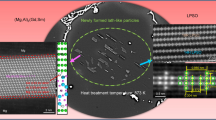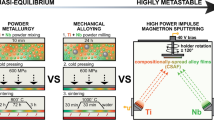Abstract
Thin yttria-stabilized zirconia (YSZ) (100) transmission electron microscopy (TEM) samples prepared using 5 kV Ar ion sputtering and subsequent annealing with 5 kV electron beams under ultrahigh vacuum (UHV) environment were observed with TEM. A new phase which is electron conducting and has high electron beam tolerance is formed. The phase grows epitaxially with the YSZ matrix and has a cubic structure. It is estimated that substrate YSZ reacted with surface contaminants to from ZrC during electron beam annealing. When the substrates were thoroughly cleaned before ion beam irradiation, no new phase formation was observed. Instead, formation of faceted holes was identified.






Similar content being viewed by others
References
B.A. Boukamp, The amazing perovskite anode. Nat. Mater. 2, 294–296 (2003)
R. Vaßen, M.O. Jarligo, T. Steinke, D.E. Mack, D. Stöver, Overview on advanced thermal barrier coatings. Surf. Coat. Tech. 205, 938–942 (2010)
N. Miura, M. Nakatou, S. Zhuiykov, Impedancemetric gas sensor based on zirconia solid electrolyte and oxide sensing electrode for detecting total NOx at high temperature. Sens. Actuators B 93, 221–228 (2003)
M.N. Tsampas, F.M. Sapountzi, P. Vernoux, Applications of yttria stabilized zirconia (YSZ) in catalysis. Cat. Sci. Tech. 5, 4884–4900 (2015)
P. kalita, S. Ghosh, G. Sattonnay, U.B. Singh, V. Grover, R. Shukla, S. Amirthapandian, R. Meena, A.K. Tyagi, D.K. Avasthi, Role of temperature in the radiation stability of yttria stabilized zirconia under swift heavy ion irradiation: a study from the perspective of nuclear reactor applications. J. Appl. Phys. 122, 025902 (2017)
G. Velişa, A. Debelle, L. Thomé, S. Mylonas, L. Vincent, A. Boulle, J. Jagielski, D. Pantelica, Implantation of high concentration noble gases in cubic zirconia and silicon carbide: a contrasted radiation tolerance. J. Nucl. Mat. 451, 14–23 (2014)
U. Vohrer, H.–D. Wiemhfer, W. Göpel, B.A. von Hassel, A.J. Burggraaf, Electronic properties of ion-implanted yttria-stabilized zirconia. Solid State Ionics 59, 141–149 (1993)
W.C. Simpson, W.K. Wang, J.A. Yarmoff, T.M. Orlando, Photon- and electron-stimulated desorption of O+ from zirconia. Surf. Sci. 423, 225–231 (1999)
G.M. Ingo, G. Marletta, Ion beam induced reduction of metallic cations in yttria-zirconia. Nucl. Inst. Met. Phys. Res. B 116, 440–446 (1996)
M. Cotter, R.G. Egdell, Electron beam reduction of cubic Y-doped ZrO2(100): a study by X-ray photoelectron spectroscopy. J. Solid State Chem. 66, 364–368 (1987)
J.S. Moya, R. Moreno,, J. Requena, Black color in partially stabilized zirconia. J. Am. Ceram. Soc. 71, C479–C480 (1988)
R.W. Rice, Comment on “Black color in partially stabilized zirconia”. J. Am. Ceram. Soc. 74, 1745–1746 (1991)
X. Guo, Y.–Q. Sun, K. Cui, Darkening of zirconia: a problem arising from oxygen sensors in practice. Sens. Actuators B 31, 139–145 (1996)
V.R. Pai Verneker, D. Nagle, Effect of reduction on vickers hardness of stabilized zirconia. J. Mat. Sci. Lett. 9, 192–194 (1990)
D. Nagle, V.R. Pai Verneker, A.N. Petelin, G. Groff, Optical absorption of electrolytically colored single crystals of yttria-stabilized zirconia. Mat. Res. Bull. 24, 619–623 (1989)
D.J. Barber, Radiation damage in ion-millled specimens: characteristics, effects and methods of damage limitation. Ultramic. 52, 101–125 (1993)
J.F. Ziegler, J.P. Biersack, The stopping and range of ions in matter (SRIM, Version 2013)
J. Cazaux, Correlations between ionization radiation damage and charging effects in transmission electron microscopy. Ultramic 60, 411–425 (1995)
R.F. Egerton, P. Li, M. Malac, Radiation damage in the TEM and SEM. Micron 35, 399–409 (2004)
R.J. Nicholls, N. Ni. S. Lozano-Perez, A. London, D.W. McComb, P.D. Nellist, C.R.M. Grovenor, C.J. Pichard, J.R. Yates, Crystal structure of the ZrO phase at zirconium/zirconium oxide interfaces. Adv. Eng. Mat. 17, 211–215 (2015)
G. Velişa, S. Mylonas, P. Trocellier, L. Thomé, A. Debelle, S. Vaubaillon, C. Bachelet, Ion beam syntheses of ZrCxOy nanoparticles in cubic zirconia. J. Appl. Phys. 119, 165902 (2016)
J.J. Hren, Specimen contamination in analytical electron microscopy: sources and solutions. Ultramic 3, 375–380 (1979)
R.G. Green, L. Barré, J.B. Giorgi, Nano-structures in YSZ(100) surfaces: implication for metal deposition experiments. Surf. Sci. 601, 792–802 (2007)
M.W. Chase, N.I.S.T.-J.A.N.A.F. Thermochemical, Am Ceram Soc and Am Inst Phys. (NIST, Gaithersburg, 1998)
A.H. Heuer, V.L.K. Lou, Volatility diagrams for silica, silicon nitride, and silicon carbide and their application to high-temperature decomposition and oxidation. J. Am. Ceram. Soc. 73, 2789–2803 (1990)
P. AMaitre, Lefort, Solid state reaction of zirconia with carbon. Solid State Ionics 104, 109–122 (1997)
D.–W. Lee, S.–M. Jin, J.–H. Yu, H.–M. Lee, Synthesis of ultrafine ZrC powders by novel reduction process. Mater. Trans. 51, 2266–2268 (2010)
M. Tanaka, K. Furuya, M. Takeguchi, T. Honda, Surface observation of Mo nanocrystals deposited on Si (111) thin films by a newly developed ultrahigh vacuum field-emission transmission electron microscope. Thin Solid Films 319, 110–114 (1998)
A. Agrawal, J. Cizeron, V.L. Colvin, In situ high-temperature transmission electron microscopy observation of the formation of nanocrystalline TiC from nanocrystalline anatase (TiO2). Microsc. Microanal. 4, 269–277 (1998)
J. Rankin, B.W. Sheldon, In situ TEM sintering of nano-sized ZrO2 particles. Mater. Sci. Eng. A 204, 48–53 (1995)
M.R. MacCartney, D.J. Smith, Studies of electron irradiation and annealing effects on TiO2 surfaces in ultrahigh vacuum using high-resolution electron microscopy. Surf. Sci. 250, 169–178 (1991)
Author information
Authors and Affiliations
Corresponding author
Rights and permissions
About this article
Cite this article
Tanaka, M. Ion- and electron-beam-induced structural changes in cubic yttria-stabilized zirconia. Appl. Phys. A 124, 647 (2018). https://doi.org/10.1007/s00339-018-2074-7
Received:
Accepted:
Published:
DOI: https://doi.org/10.1007/s00339-018-2074-7




